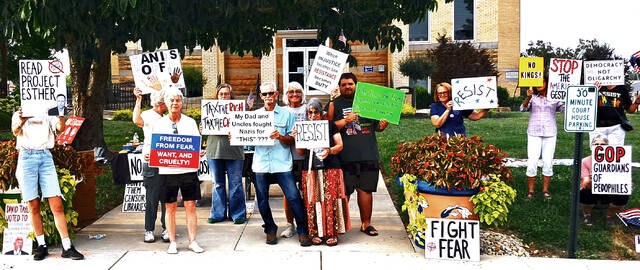
A small group of protesters gathered in front of the Adams County Courthouse on Friday, August 15. (Photo by Ryan Applegate)
By Ryan Applegate
People’s Defender
A small group of residents gathered outside the Adams County Courthouse in West Union on Friday, August 15 to protest federal policy changes and to call for more direct engagement from their elected officials.
Thirteen people attended the event, which was organized by Adams County resident Taryn. Demonstrators held signs and spoke to passersby about their concerns. The protest remained peaceful throughout the evening, and there was no law enforcement presence.
Taryn said the protest was aimed at drawing attention to several issues, with rural healthcare at the forefront. She expressed concern that local hospitals, including Adams County Regional Medical Center (ACRMC), could face financial trouble due to Medicaid funding cuts. “It’s one of our only hospitals, and it’s going to take a long time for us to get somewhere else if an emergency happens,” she said.
Her statement came in the wake of national reports earlier this summer identifying 11 rural Ohio hospitals considered at risk of closure or service reductions. Adams County Regional Medical Center appeared on that list. However, in a June 26 public statement, ACRMC CEO Alan Bird assured the community that the hospital is not in danger of shutting its doors. “We are stable, growing, and planning for the future,” Bird wrote, adding that ACRMC continues to expand services and invest in new technology.
When asked about that reassurance, Taryn pointed to what she described as research conducted by organizations such as Policy Matters Ohio, a Cleveland-based think tank. After an independent review, documentation from Policy Matters Ohio specifically stating that ACRMC was at risk of closing was not available on the Policy Matters Ohio website. The group has published policy analysis on healthcare funding and Medicaid in Ohio but not the claims attributed to it by the protest organizer.
Despite that gap, Taryn maintained that broader financial pressures—including increased costs and reduced funding—make rural healthcare vulnerable. She argued that local residents should be paying close attention to developments at both the state and federal level.
The protesters also directed frustration toward U.S. Representative David Taylor, who represents the district. Taryn said Taylor has not hosted a town hall open to all constituents. “He only speaks to donors and people who have money,” she said. “We’re just hoping he sees us and will have a town hall.”
Demonstrators emphasized that the protest was not tied to one political party. Taryn said that while she personally is not a Republican, about half of the group identifies as such. “They are registered Republicans. They’re also confused on what’s happening. It’s not what they voted for,” she said.
The group’s concerns extended beyond healthcare and local representation. Signs and conversations touched on the elimination of public media funding, which protesters said would reduce access to emergency broadcasting and local news while also eliminating jobs. “Public media being taken away means farmers won’t have access to information, people will lose jobs, and we lose part of our community voice,” Taryn explained.
Immigration enforcement also came up during the protest. Taryn referenced reports of detainees in Butler County Jail, saying that many held by Immigration and Customs Enforcement there do not have criminal records. She described this as an example of federal overreach.
International solidarity was another theme. Several demonstrators voiced support for people in Palestine, Sudan, and the Democratic Republic of Congo, criticizing U.S. foreign spending. Protest signs referenced overseas conflicts alongside messages about Medicaid, Social Security, and local hospital access.
This was not the first demonstration for the group. Earlier this year, the same organizers held a protest in Peebles. They said they plan to continue their activities and invited other residents to join. “If you want to stand up for one thing, that’s all that matters,” Taryn said. “Your Social Security, Medicaid, SNAP benefits are all at risk. We want to protect our neighbors.”
Although turnout was small—just over a dozen people—the protest drew attention from drivers passing by. Several honked their horns or waved in apparent support. No counterprotesters were present.
The day ended without incident, as demonstrators gradually dispersed from the courthouse square. While the long-term impact of the protest remains to be seen, the participants said they hoped it would send a message that people in Adams County are watching the effects of federal policy and want more opportunities to speak directly with their representatives.
The protest highlighted the tension between national reporting on rural healthcare challenges and local reassurances from providers. With Adams County Regional Medical Center publicly stating it is not at risk of closure, and no independent confirmation of the contrary, the hospital’s future remains a point of debate in the public discourse. For the dozen or so residents who stood on the courthouse square on Friday, raising that debate in a visible way was the goal.




